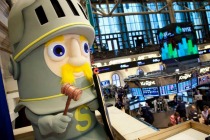Sir Can-a-Lot, the official mascot of Spam lunch meat, stepped up to the lectern. According to the press release, the canny knight had come to New York “to rescue the world from routine meals.” At precisely 4 p.m., with the words “Glorious Spam” hanging in the background, the processed meat hero slammed down the gavel to a weak smattering of applause. Trading on the New York Stock Exchange was officially closed for the day.
At the same time, more than 20 “off-exchange” market centers called “ATSs” (Alternative Trading Systems) also closed for the day. Unlike the NYSE, they did it quietly. Fills and “Nothing Dones” were sent to customers, clearing files were processed, and employees began heading home for dinner. No mascots pranced, no bells clanged, and no TV cameras were around.

The floor of the NYSE certainly looks and sounds different from the off-exchange electronic platforms out there. And maybe that is why reporters seem to think there are big, important differences between the two. A recent editorial in the New York Times (“Trading in the Dark,” April 6, 2013) called for “a strong regulatory response” to stop volume from migrating from “public exchanges” to “private trading venues.” Yes, the same New York Times that has called all trading “socially useless” was now declaring off-exchange trading to be even worse.
I found myself confused by their passion for exchange trading. Because after the past decade of market structure changes, the difference between exchange trading and off-exchange trading has blurred to the point where there really isn’t that big a distinction.
When you cut to the chase, there are two ways to trade in the U.S. markets: lit or dark. In a “lit” order, your bid is displayed for the world to see. In a “dark” order, your bid sits in a computer unseen. Based on market conditions, professional traders judge whether or not they are more likely to get the best price for their fund-holders using lit or dark orders. Either way, when there is a successful match, all trades must be immediately printed to the tape-trades in the U.S. cannot be done in secret.
The New York Times seems to understand the difference between dark and lit trading. But then its editors veer down an incorrect path, making a common error of equating “lit” with “on exchange,” and “dark” with “off exchange.” What is well known in the industry, but seems poorly understood by reporters and consultants, is that exchanges like the NYSE operate large dark pools themselves. Among the 150 or so order types offered by today’s exchanges are dozens of dark varieties, as well as order types that switch between lit and dark, such as the exchange order type called “Hide Not Slide” that was the subject of a Wall Street Journal article last September.
Exchanges do not disclose the breakdown of their volume by order type, but there are clues. In 2008, the NYSE Arca exchange ran an ad that proudly announced, “NYSE Arca trades over 500 million shares of dark liquidity, daily.” The fine print said its numbers were based on trading data from March 2008 through August 2008. NYSE Arca’s average volume for that period was 1.34 billion shares per day, which means that using its declared 500 million share number, more than 37 percent of NYSE Arca volume was dark in 2008.
The same year, the NYSE floor also boasted about the size of its dark pool. Right here in my favorite publication, Traders Magazine, they wrote in an advertisement, “NYSE has long been the deepest pool of dark liquidity-in fact, on average over 200 million shares of dark liquidity trade every day on the NYSE.”
OK, so exchange trading is sometimes dark. But off-exchange trading is always dark, right? Well, no. Many off-exchange market centers show bids and offers in the National Market System. Currently, Bloomberg’s Tradebook, Citigroup’s Lavaflow and Credit Suisse’s Light Pool are all “public” off-exchange venues, in that they publicly display bids and offers.
So the New York Times’ beef is presumably not about dark trading, or they would presumably be against on-exchange dark trading and in favor of off-exchange lit trading. Instead they portrayed all “public” exchange activity as good and all “private” off-exchange trading as bad, regardless of its dark or lit status.
I’m still not sure what they mean by “public” exchanges. If the New York Times is under the impression that exchanges are still mutualized not-for-profits, they are wrong. All 13 exchanges in the U.S. are for-profit businesses operated to make money for their owners. So maybe they mean public vs. private in the sense of public vs. private golf courses, as in “open to the public.” Exchanges are supposed to have “fair access” policies in place, so all broker-dealers can play for the same fees. But take one look at the monthly “Price of Liquidity” pages at the back of this magazine (p. 42) and you will see that changes don’t really treat all clients the same.
Exchanges have become masters at carving out elaborate requirements to tailor their “maker/taker” pricing to individual clients.
To qualify for a particular rebate, a client may need to trade more than 0.7 percent of total U.S. volume using a particular order type, while “adding” at least 2 million shares per day, and “taking” at least 4 million. Meanwhile, there are endless categories of special deals. The NYSE has different rebate and fee schedules and different priority rules for retail flow, floor brokers, “supplemental liquidity providers” and “designated market makers.” Yes, the public is welcome, but hopefully they understand that the guy who walked in 10 minutes after them may be ahead in line, and may be paying a lower fee.
The bottom line is that exchanges and off-exchange ATSs are more similar than different. They are both for-profit businesses. They both offer dark and lit order types. And they both create pricing plans designed to maximize their profit. As a result, the line between exchange and off-exchange trading is blurrier than it’s ever been.
That is why exchanges care more about branding than ever before, and why they are installing TV studios and loading up on celebrity bell-ringers. As their functionality blurs with off-exchange platforms, and it all starts being the same, it is more important than ever for exchanges to visually differentiate themselves to the public at large. A public that doesn’t see exchanges as special won’t trigger the “strong regulatory response” to lost market share that the New York Times is yearning for.
But there is still one part of the day when the NYSE doesn’t need a “strong regulatory response” to rescue them. Some habits die hard, and to this day, the listing exchanges are the only game in town at the time of the bell. A recent study by Credit Suisse analyst Ana Avramovic showed a full 25 percent of the NYSE’s volume now happens on the open or the close.

So it makes sense that the NYSE celebrate these rare moments of exchange liquidity with celebrities and bells and clapping. On-exchange and off-exchange trading may look the same most of the day, but at that moment the gavel drops, the NYSE still dominates. They may have lost their monopoly the rest of the day. They may have lost the crowds and the paper and the adrenaline and the fun of being at the center of it all.
But they’ll always have Sir Can-a-Lot.
Dan Mathisson is a columnist for Traders Magazine, and the Head of U.S. Equity Trading at Credit Suisse. The opinions expressed in this column are entirely his own, and do not necessarily represent the opinions of the Credit Suisse Group.



